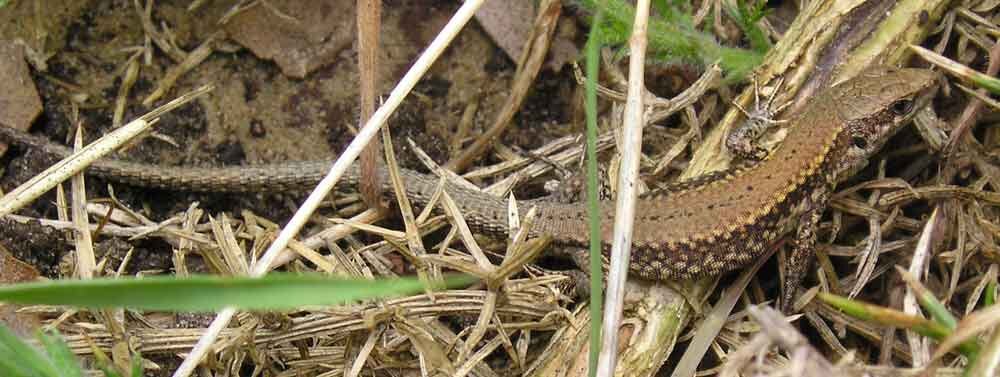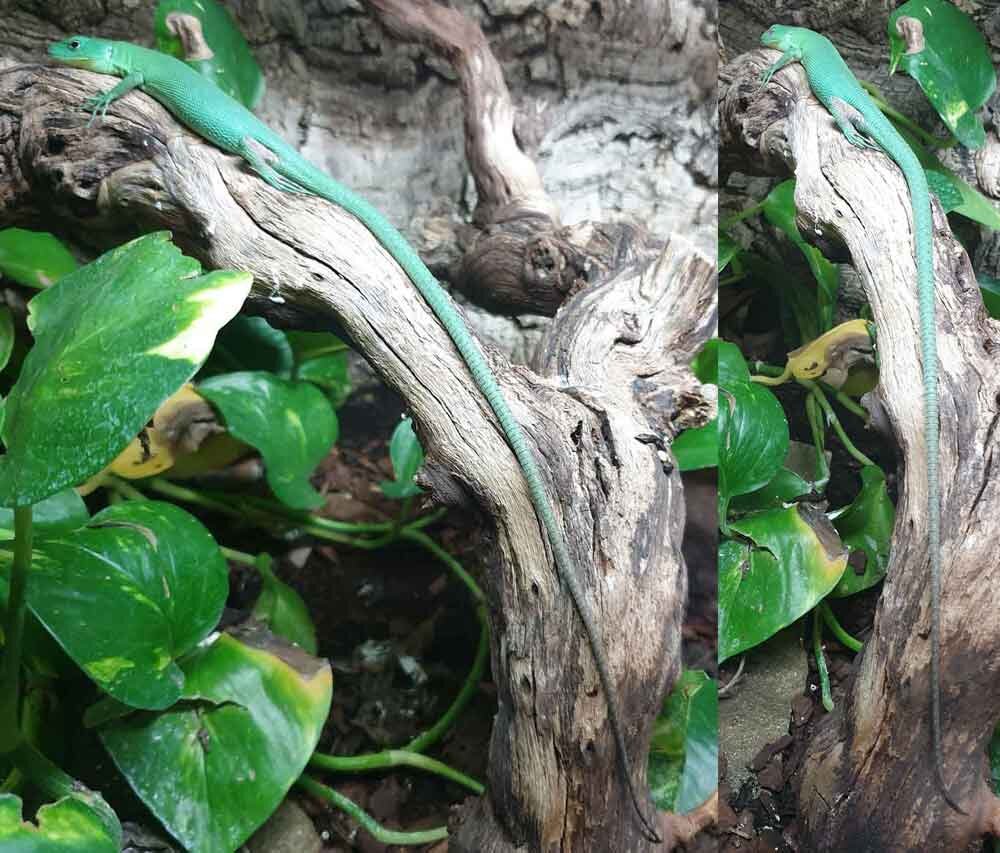TetZoo hasn’t had nearly enough lizards lately. If you’re a regular reader you might recall the slow-burn series on LACERTIDS, the Old World group that are the ‘typical’ lizards of western and central Europe and hence the first group to become known to European scientists.
Caption: if you’re European, lacertids are the lizards you know best. In the UK, we only have two natives, one of which is Zootoca vivipara, the Viviparous lizard. Here’s a wild individual. Image: Darren Naish.
European lacertids – thinking here of Zootoca (viviparous lizards), Lacerta (sand lizards, green lizards and kin) and Podarcis (wall lizards) in particular – are quite well known and it’s easy to find information on them; if, that is, you’ve combed through books on lizards in quest of hot lacertid info. But there are a whole bunch of African taxa within Lacertidae: what’s the deal with them, and why don’t we hear more about them? Well, comparatively little is known about them, good photos of them aren’t that abundant, and they’re rare in museum collections (Arnold 2004).
Caption: a captive Green keel-bellied lizard Gastropholis prasina, in repose. Check out that tail! Images: Darren Naish.
I recently got to see a live lacertid of a type I’d never seen before: a Green keel-bellied lizard Gastropholis prasina, a shockingly long-tailed, green, east African lacertid endemic to the coastal forests of Mozambique, Tanzania and Kenya. It reaches 40 cm in total (which seems pretty huge for a lacertid), but is more usually 25-35 cm. Most of this is formed by the slender, prehensile tail. These are diurnal lizards, and one of several things that makes them unusual among lacertids is that they’re arboreal, and do just about everything up in the trees. They sleep there, fight there, mate there and lay their eggs there (in damp hollows). Individuals of G. prasina have been found 12 metres up in trees (Spawls et al. 2018).
Caption: an 1886 illustration of the Striped keel-bellied lizard G. vittata, from J. G. Fischer’s publication. Image: J. G. Fischer, public domain.
Well…. the Green keel-bellied lizard lives this way, anyway. Animals refuse to be constrained by anatomy and not all members of this genus are arboreal. The Striped keel-bellied lizard G. vittata is apparently terrestrial despite being proportionally pretty much exactly like G. prasina and being equipped with a really long, prehensile tail (Spawls et al. 2018). What this most likely shows is that G. vittata has only recently transitioned to terrestrial life, and that its anatomy still harks back to an arboreal ancestry.
Caption: you can see why this species is called Gastropholis echinata (the species name meaning ‘spiny’). It’s from a 1919 description of the species by K. P. Schmidt. Image: K. P. Schmidt/AMNH, public domain.
Two other species are presently included in Gastropholis. G. echinata occurs throughout those countries bordering the Gulf of Guinea while G. tropidopholis is endemic to the Democratic Republic of the Congo.
Caption: another Gastropholis species: the Congolese G. tropidopholis. Again this image is from a 1919 paper by K. P. Schmidt. Image: K. P. Schmidt/AMNH, public domain.
Convergence with grass lizards…. and monitors? As implied by the name, one of the unusual things about these lizards is that their ventral scales are keeled. That’s pretty odd, since lizards (and other reptiles) ‘ordinarily’ have smooth ventral scales. Keeled ventral scales are also present in at least some species of Adolfus – another climbing African lacertid – and also in Takydromus, the east Asian grass lizards. Like Gastropholis, Takydromus has a strikingly long tail which it uses in climbing (albeit in grasses rather than high in trees).
These lizards also (together with Philochortus, another poorly known African lacertid) share especially tall, blade-like neural spines on some of their caudal vertebrae (Arnold 1997, 2004). Neither Takydromus nor Philochortus are at all close to Gastropholis in lacertid phylogeny, so any similarities have to be a product of convergence (Arnold 2004). If you want to learn more about Takydromus, I wrote about it here at ver 2, back in 2013.
Caption: a Takydromus - an Asian grass lizard - in captivity. These lacertids are similar to the African Gastropholis species in several respects, but are not that closely related to them. Image: Darren Naish.
On the subject of convergence, I can’t help but also regard these mostly arboreal, often green lacertids as convergent with the also long-tailed, also green prasinoid tree monitors of northern Australasia. Prasinoids – the Green tree monitor Varanus prasinus and its several close relatives – are larger than Gastropholis species (40 cm vs 60-110 cm, total length) and have several varanid-flavoured features lacking in lacertids (a long forked tongue, blade-like teeth, longer and more dextrous digits and – probably – enhanced cognition). Prasinoids seem more formidable as predators than is Gastropholis, since they predate on small mammals, big spiny insects and so on. This could just be a consequence of size though, and Gastropholis is reported to predate on smaller lizards so might well be quite formidable too (Spawls et al. 2018). If you’re wondering why there are both Varanus and Gastropholis taxa within the species name prasinus (or prasina), it’s because this means ‘light green’.
Caption: I’ve had reason to draw prasinoids - green tree monitors - on several occasions, and here’s a montage depicting several species. Can these varanids be considered convergent with the long-tailed, arboreal lacertid Gastropholis? Hmm, maybe. Images: Darren Naish.
I’ve written about prasinoids at TetZoo: please go here (reminder that I now link to wayback machine versions of my ver 3 articles, since SciAm has either mutilated my articles or paywalled them).
Where in the family tree? Where do the Gastropholis species fit within the lacertid radiation? None of these lizards are well known and they tend to be missed entirely from popular works that mention or discuss lacertids, this creating the impression that Lacertidae doesn’t really have a presence in the African tropics, which it totally does. Within recent decades it’s been widely agreed that these lizards are part of the equatorial lacertid clade that includes Adolfus and kin. This whole group is probably part of Eremiadini, the lacertid clade that also includes the fringe-toed lizards (Acanthodactylus) and racerunners (Eremias) (e.g., Peréz I de Lanuza & Font 2014)… though be sure to see the TetZoo article on racerunners and kin to get some perspective on the different phylogenetic proposals that have been put forwards for these animals.
Caption: a substantially simplified lacertid phylogeny, showing the approximate structure pieced together in assorted studies. Gastropholis by Darren Naish, Acanthodactylus by Richard Hing, Eremias by Yuriy75 (CC BY-SA 3.0; original here), Takydromus by Acapella (CC BY-SA 3.0; original here), Lacerta by Darren Naish, Gallotia by Petermann (CC BY-SA 3.0; original here), Psammodromus by Wolfgang Wüster. Image CC BY-SA.
Arnold (1989) examined anatomical features and found Gastropholis to form a clade with Bedriagaia, Holaspis and Adolfus, the four forming what he termed ‘the Equatorial African clade’. I have to mention in passing that Holaspis is especially interesting because it’s able to glide and has seemingly evolved this ability as an exaptation (Arnold 2002). That’s a story for another time though. Greenbaum et al. (2011), using data from several genes, found Gastropholis to be the sister-group to Adolfus sensu stricto (Adolfus of tradition is paraphyletic with respect to Holaspis, so some of its populations are now separated and in the 2011 genus Congolacerta).
A note on the future. What else do we know about these lizards? They’re suspected to be in decline, given that the forests they inhabit are being destroyed, but hints that they might be adaptable enough to persist come from the fact that they’ve moved into cash crop plantations in some places (Spawls et al. 2018). The individual shown in my photos above and below is a captive and part of the pet trade. The trade in exotic reptiles (and amphibians) is mostly evil, exploitative and the opposite of anything that can be considered sustainable and beneficial. Having said that, the fact that populations of animals endangered in the wild are now being bred in captivity might provide some kind of safeguard for the future. That’s where we’ll end for now, but we’ll return to lacertids - and other lizards - sometime in the near future.
Caption: Green keel-bellied lizard in profile. Image: Darren Naish.
For previous TetZoo articles on lacertids (linking here to wayback machine versions to avoid issues with the hosting sites, SciAm in particular), see…
The New Forest Reptile Centre, August 2012
Tale of the Takydromus, September 2013
Racerunner Lizards of the World Unite, October 2014
Refs - -
Arnold, E. N. 1997. Interrelationships and evolution of the east Asian grass lizards, Takydromus (Squamata: Lacertidae). Zoological Journal of the Linnean Society 119, 267-296.
Arnold, E. N. 1989. Towards a phylogeny and biogeography of the Lacertidae: relationships within an Old-World family of lizards derived from morphology. Bulletin of British Museum of Natural History (Zoology) 55, 209-257.
Arnold, E. N. 2002. Holaspis, a lizard that glided by accident: mosaics of cooption and adaptation in a tropical forest lacertid (Reptilia, Lacertidae). Bulletin of British Museum of Natural History (Zoology) 68, 155-163.
Arnold, E. N. 2004. Overview of morphological evolution and radiation in the Lacertidae. In Pérez-Mellado, V., Riera, N. & Perera, A. (eds) The Biology of Lacertid Lizards. Evolutionary and Ecological Perspectives. Institut Menorquí d’Estudis. Recerca 8, 11-36.
Greenbaum, E., Villanueva, C. O., Kusamba, C., Aristote, M. M. & Branch, W. R. 2011. A molecular phylogeny of equatorial African Lacertidae, with the description of a new genus and species from the Democratic Republic of the Congo. Zoological Journal of the Linnean Society 163, 913-942.
Peréz I de Lanuza, G. & Font, E. 2014. Ultraviolet vision in lacertid lizards: evidence from retinal structure, eye transmittance, SWS1 visual pigment genes and behaviour. The Journal of Experimental Biology 217, 2899-2909.













